I believe that people born before the half of the 20th century remember these beautiful kids’ toys used for pleasure as rocking chairs. Nowadays, children typically drive miniature car toys, but many grandparents save lovely wooden pieces in their attics.
Experts believe that the oldest antique rocking horses date back to the 17th century and their production became industrialized in the late 19th century. When I remember my wooden mustang, I am overwhelmed by nostalgia, and I wish today’s children to learn how nice it was to ride over an imaginary prairie.
Table of Contents
Antique Rocking Horse History
Rocking horses are kids’ toys shaped like these beautiful animals and mounted on rockers as a replacement for rocking chairs enjoyed by adults.
In the beginning, people created rocking cradles and hobby horses, but the first rocking horse appeared in the 17th century. In that period, children’s toys were typically made of wood. For instance, hobby horses were simple sticks with a fake horse’s head on one end.
The next attempt was barrel horses from the 16th century. Those were circular logs with four legs and an attached wooden horse head. This crude toy successfully mimicked horseback and offered children a lot of joy.
Initially, rocking horses were made of solid wood, but they had a too high gravity center, causing frequent overturning. Things became better in the Victorian period when artisans placed toy horses into safety stands, preventing kids from falling over.
Woodcrafters designed rocking horses of different quality, depending on their craftsmanship. So, you could find crude and ultimate ornamented toys from the same period. However, all were hollowed, making them more stable and lighter.
Queen Victoria contributed to the popularity of these lovely toys, and people used them as a family treasure. For instance, they often incorporated baby hair, mint coins, and later baby photographs inside the wood.
The production became industrialized in the late 19th century when these beautiful toys lost something of their charm. Unfortunately, most rocking horse manufacturers stopped their output during the Great Depression, WWI, and WWII.
Antique Rocking Horses Types
You can recognize three primary antique rocking horse types with different features and prices. Let’s see.
1. Antique bow rocking horses
This antique rocking horse type with two separate wooden curves is beautiful, convenient, and comfortable to ride. It was the first model ever produced, and some pieces can be expensive, particularly early examples. The first models appeared in the 17th century.
For instance, a bow rocking horse manufactured in the mid-19th century with visible traces of wear can be worth at least $3,000. Well-preserved toys are even more valuable, and some collectors are prepared to set aside up to $7,000 for one.
2. Antique Marqua rocking horses
Safe and stable Victorian Marqua rocking horses were trendy in the 19th and early 20th centuries. Experts believe that the first model appeared in the 1880s.
Since these toys featured a frame system, making them sizable, they required more space. Fully functional pieces are typically expensive, and the early English version can reach $5,000 to $6,000 at antique auctions.
3. Antique metal rocking horses
Mass-produced antique metal rocking horses are not collectible because of the low-cost tin they were made of. They are the best example that age is not the only feature you should consider. Unfortunately, it is impossible to get more than $15 to $50 for this lovely but unwanted little rocking horse.
Antique Rocking Horse Value
Nowadays, antique rocking horses could be highly valuable, depending on the preservation level and appearance. Collectors appreciate different types and styles prevalent in various periods and recognize manufacturers by:
- Craftsmanship quality
- Used paint
- Saddle and bridle materials
- Rocker or frame look and quality
You can find inexpensive toys for only $100 on the market. However, it is necessary to set aside $2,000 to $7,000 for the best pieces produced by well-known manufacturers.
Antique rocking horse value |
||
| Year | Rocking horse | Price |
| The 1800s | Folk art rocking pine horse with glass eyes | $9,000 |
| 1910 | Large rocking horse by F.H. Ayres | $5,115 |
| The 1900s | Extra-large rocking horse by English maker J & G Lines | $4,480 |
| 1910 | Large antique rocking horse by English maker F.H. Ayres | $3,970 |
| Early 1900s | Wood rocking horse folk art toy | $3,150 |
| The 1800s | English wooden rocking horse toy with leather saddle | $2,640 |
| Unknown | Rocking horse wooden toy | $2,210 |
| The 1930s | Wooden riding horse | $2,100 |
| The 1870s | Swedish hand-carved wood rocking horse | $1,975 |
| Late 19th century | Swedish hand-painted rocking horse | $1,600 |
| Unknown | Full-carved painted large rocking horse | $1,350 |
| The 1930s | Wooden rocking horse | $1,060 |
| The 1930s | Kay Bojesen rocking horse | $993 |
| The 1800s | Victorian Papier-Mache rocking horse | $895 |
| Unknown | Toy rocking horse | $890 |
| The 19th century | Swedish rocking horse | $625 |
| 1895 to 1910 | Whitney reed Victorian glide rocking horse | $600 |
| The 1900s | Tri-cycle rocking horse | $595 |
| Unknown | Italian wooden rocking horse | $575 |
| The 1950s | French rocking horse | $480 |
| Unknown | Hand-painted Indian rocking horse | $360 |
| The 1920s | German rocking horse | $352 |
| The 1940s | Rocking horse | $265 |
| The 19th century | Wooden rocking horse | $240 |
| Unknown | Dutch rocking horse toy | $145 |
| The 1950s | English wooden toy pull horse | $138 |
| The 1950s | Kids’ wooden rocking horse toy | $93 |
The biggest question is whether to restore antique rocking horses or save them untouched. Such a decision significantly affects their prices. Unfortunately, the crucial problem is the lack of qualified professionals who can do the job.
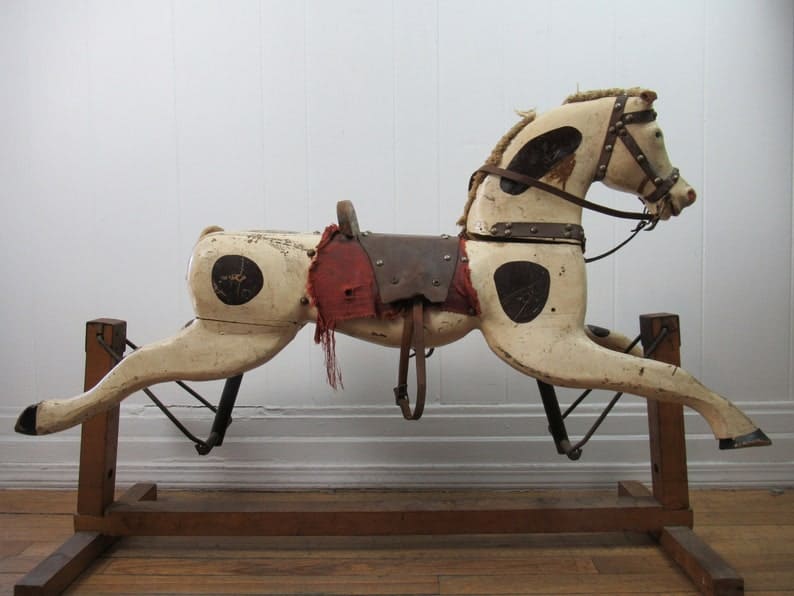
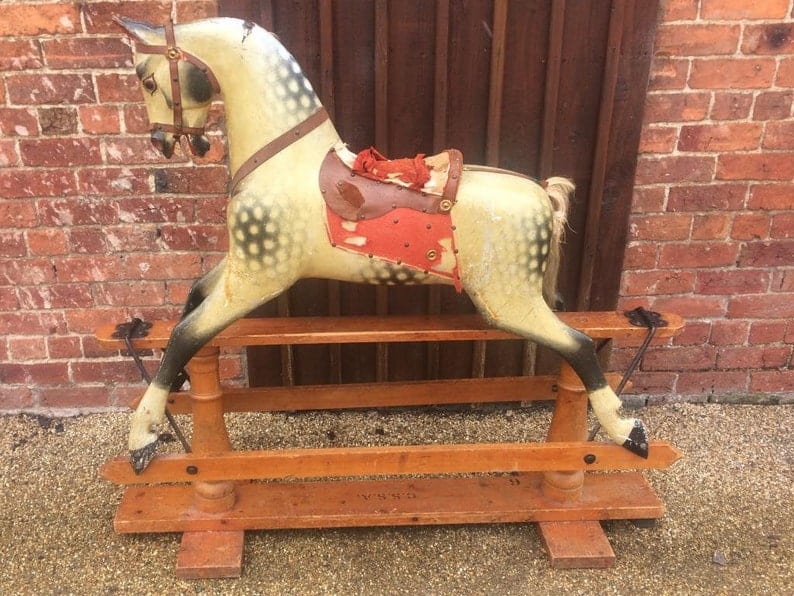
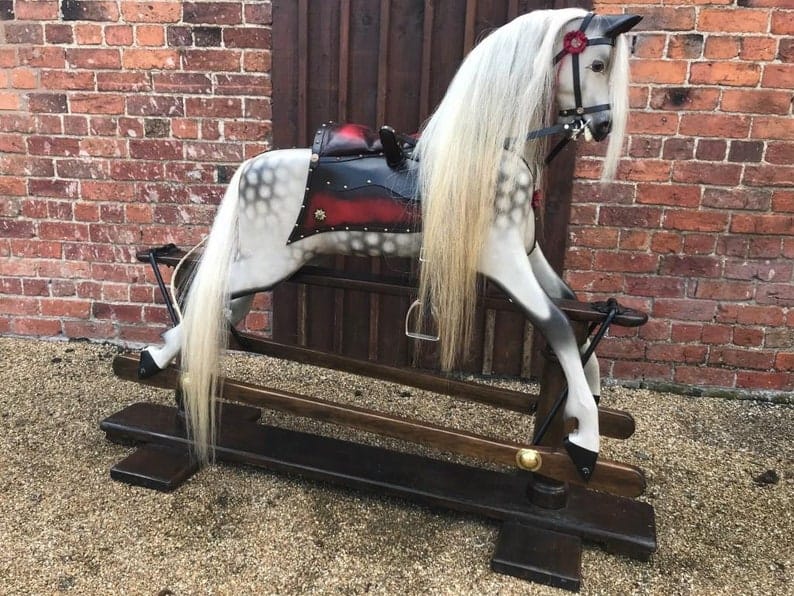
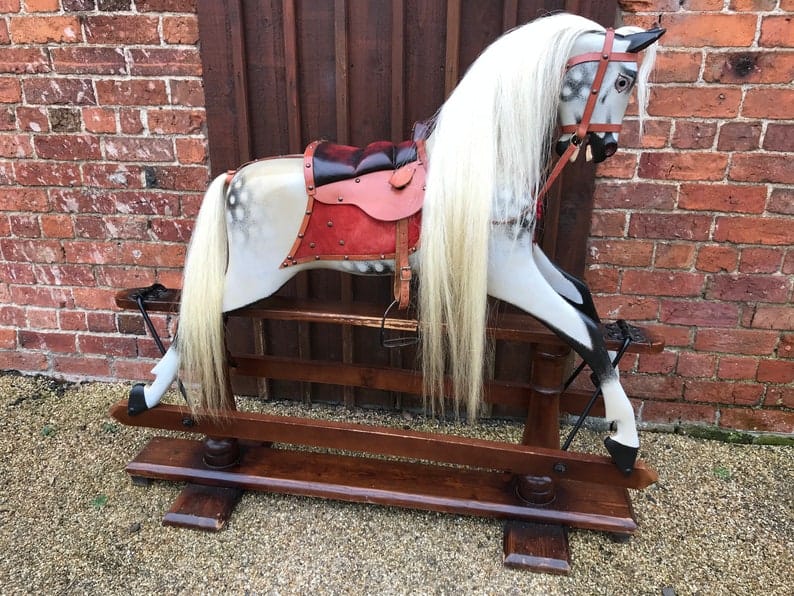
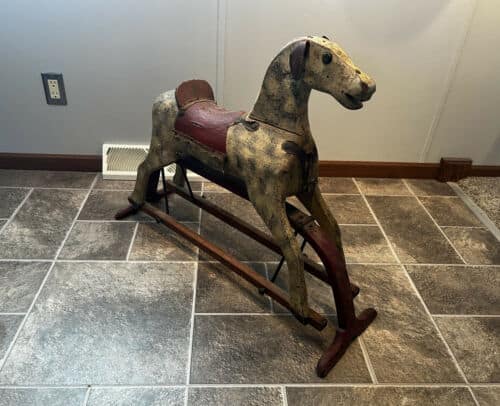
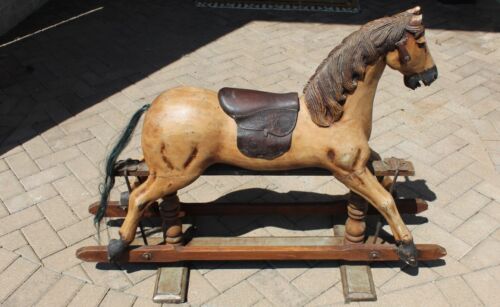
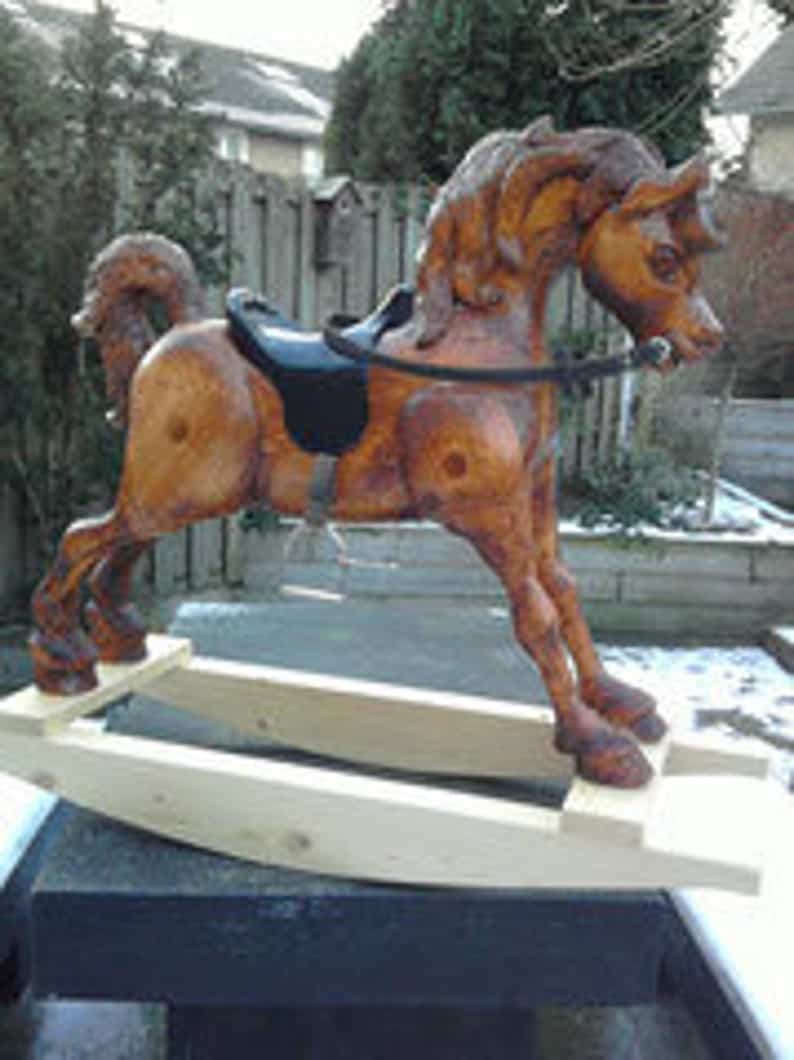
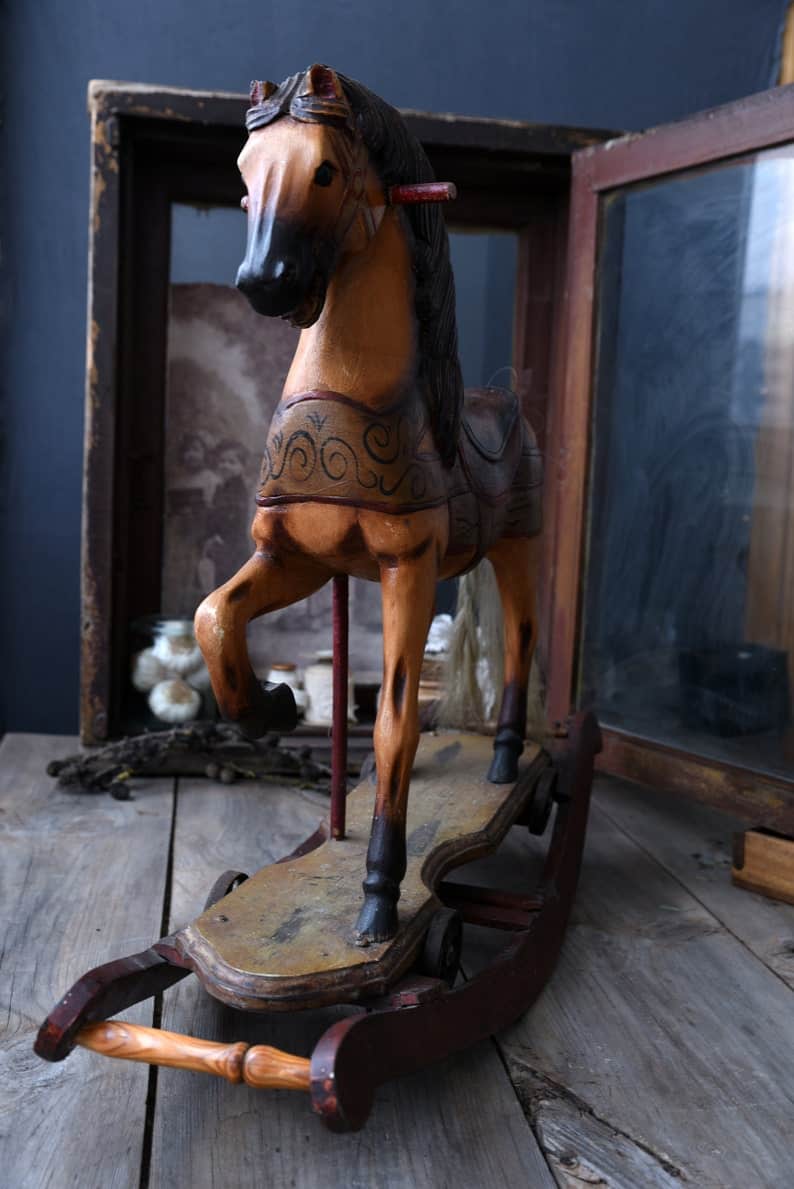
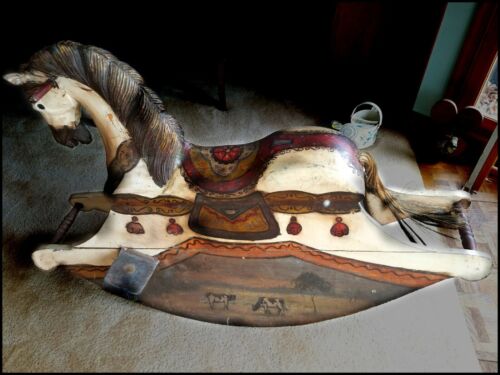
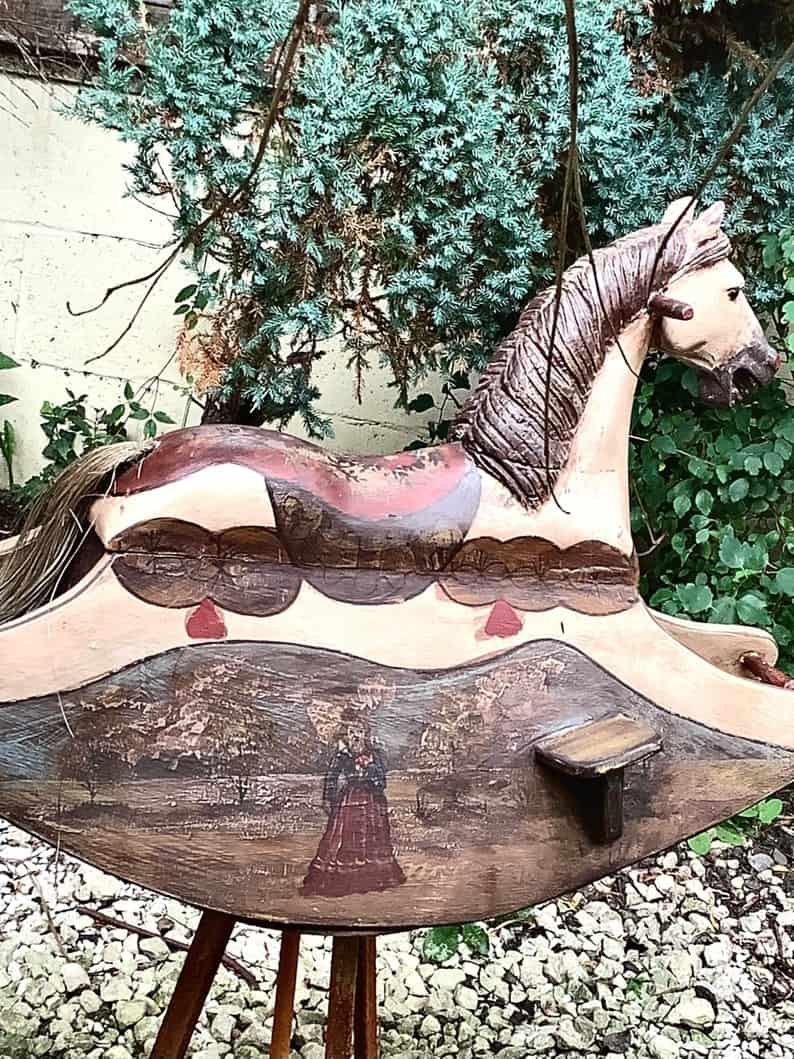
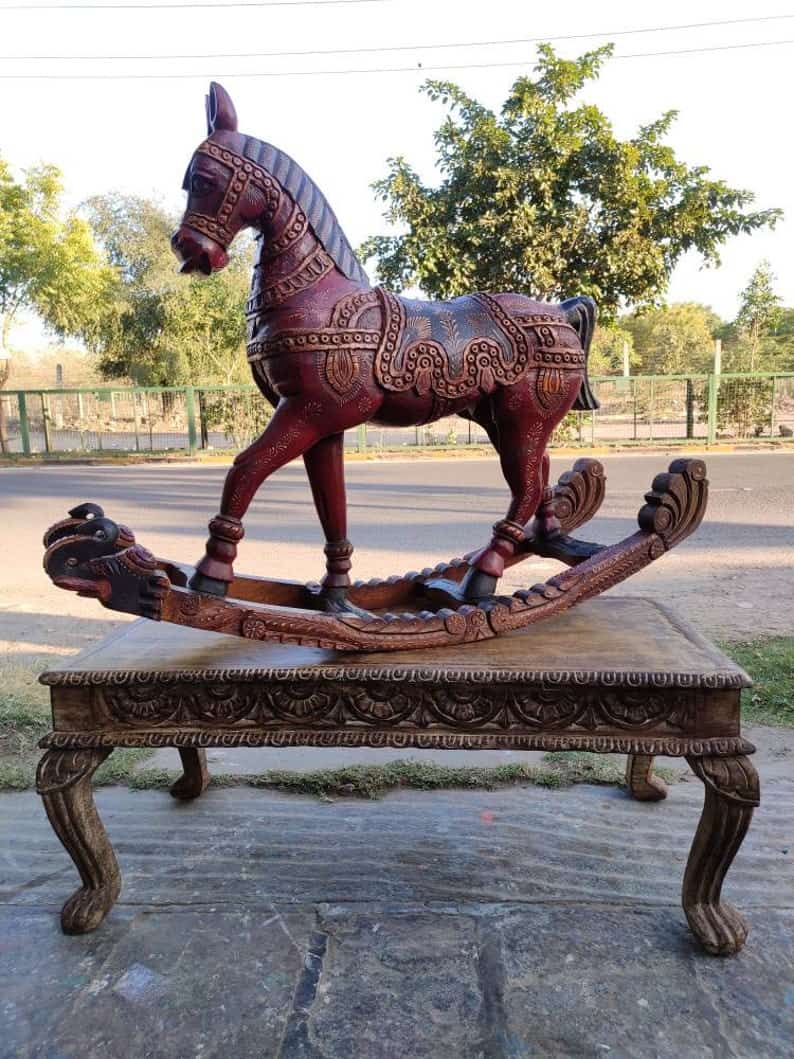
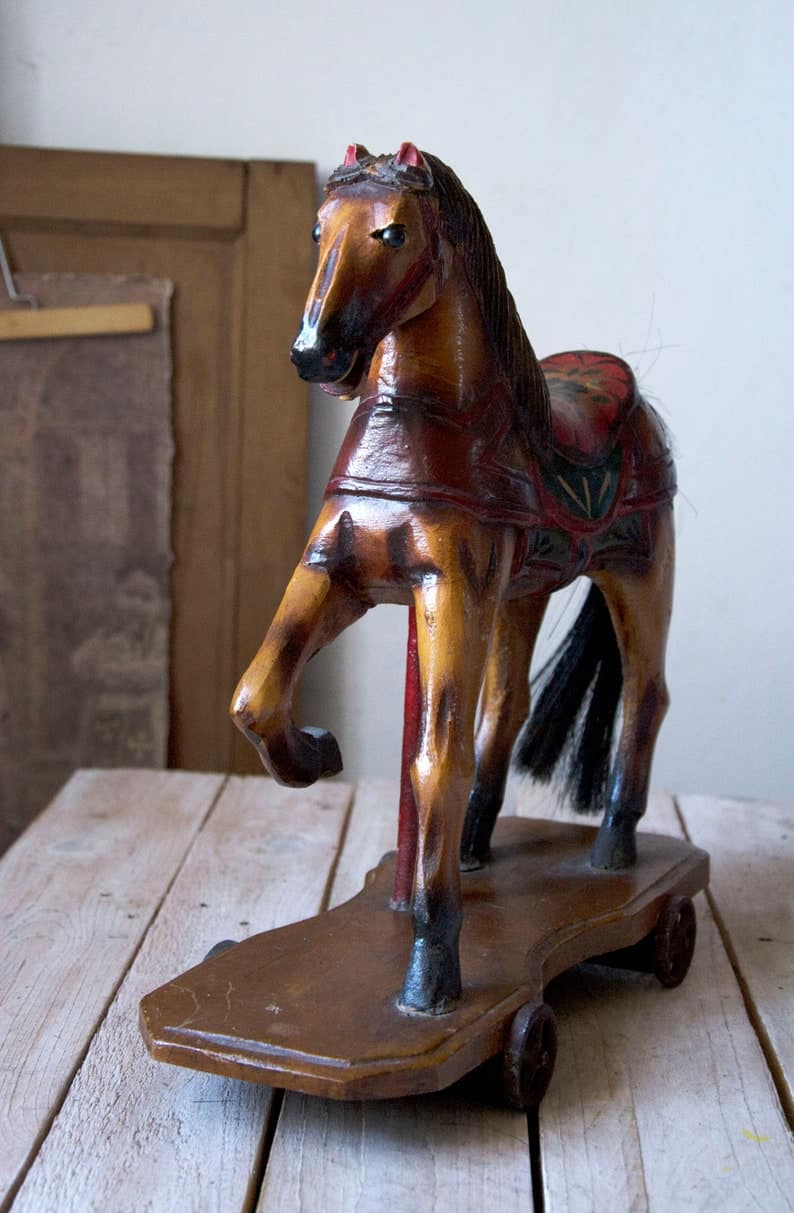
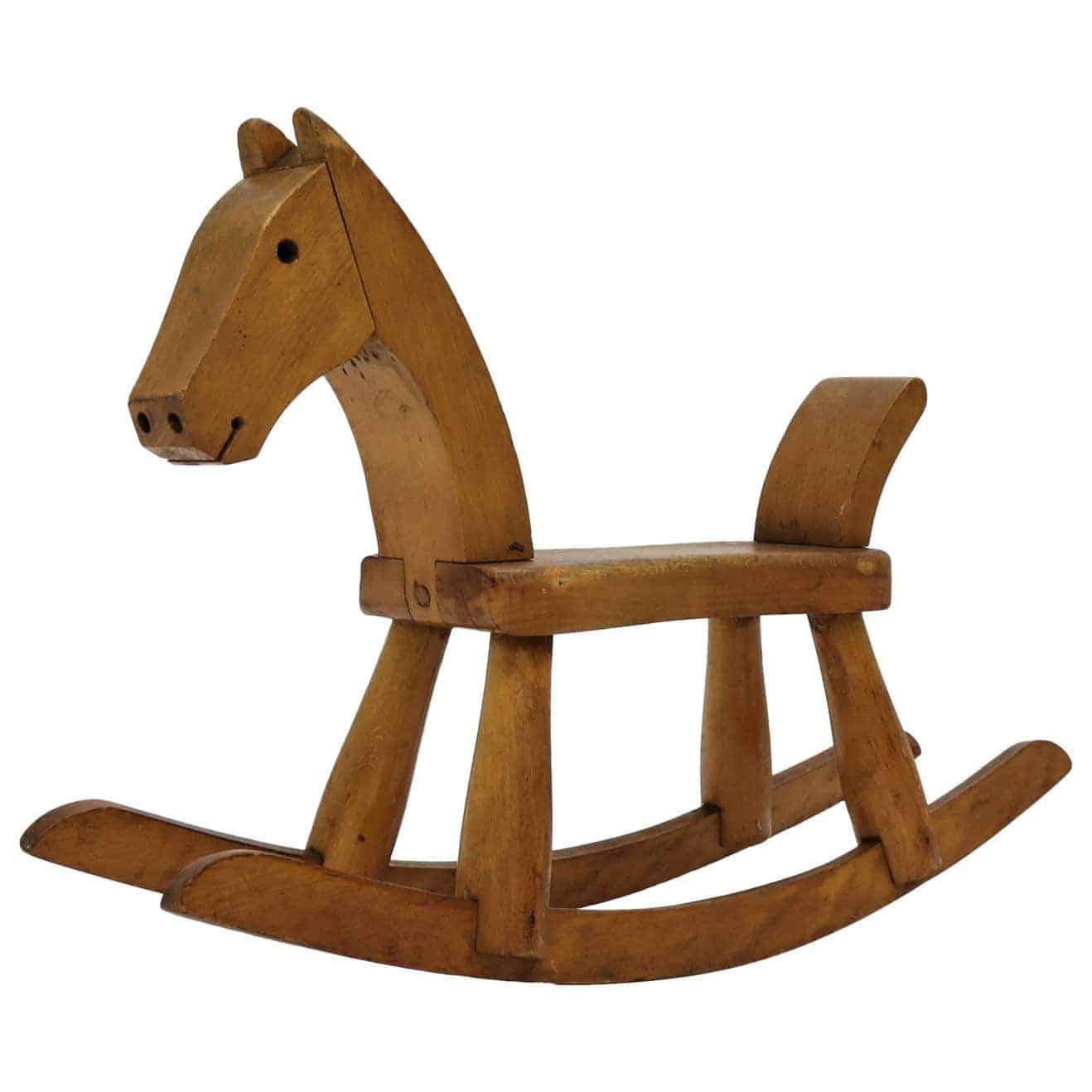
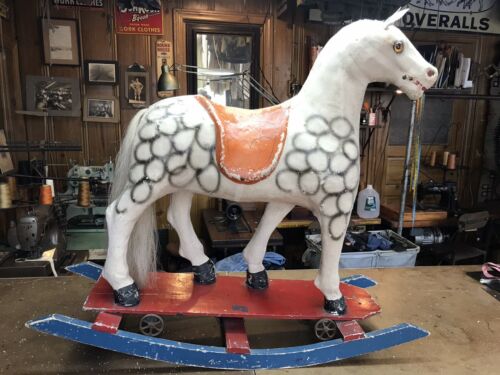
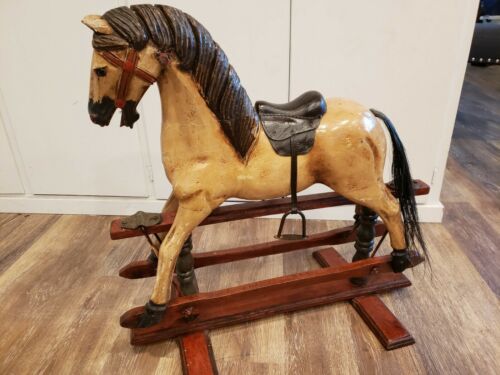
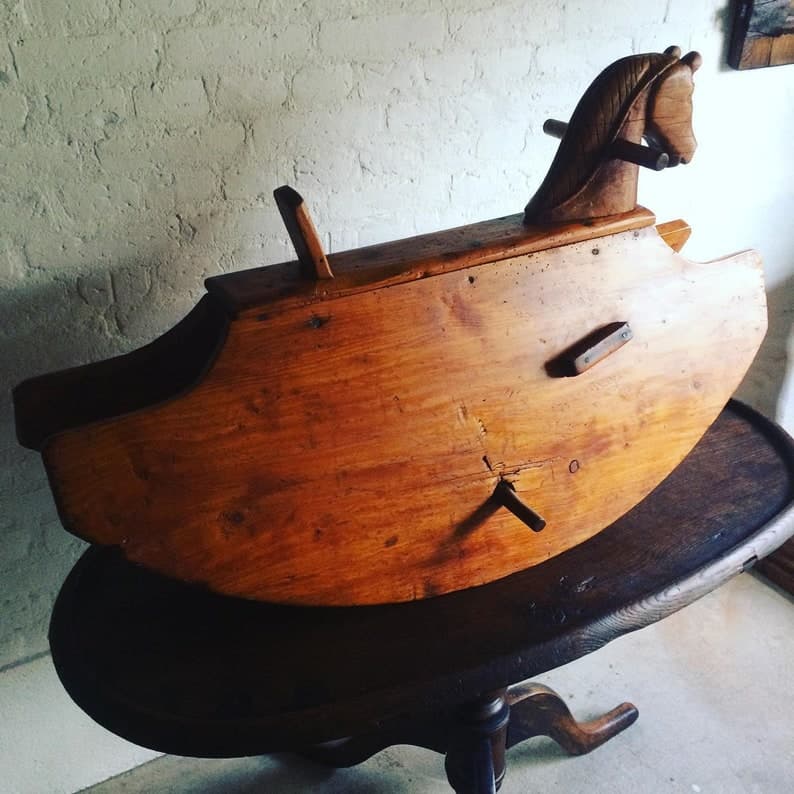
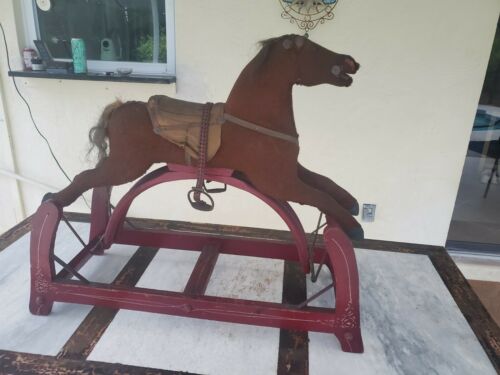
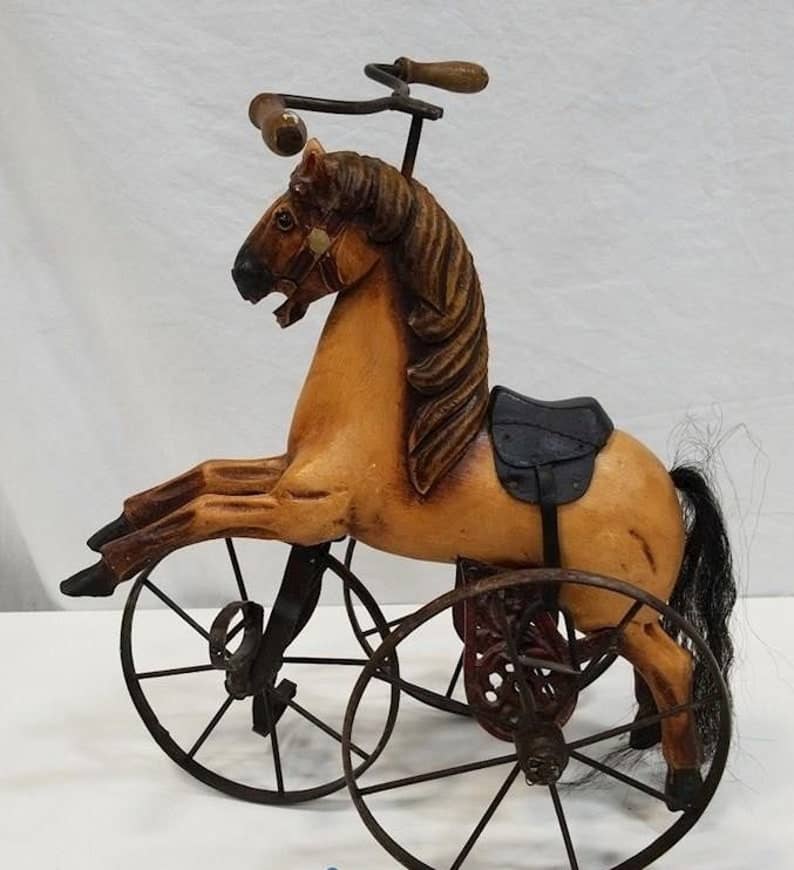
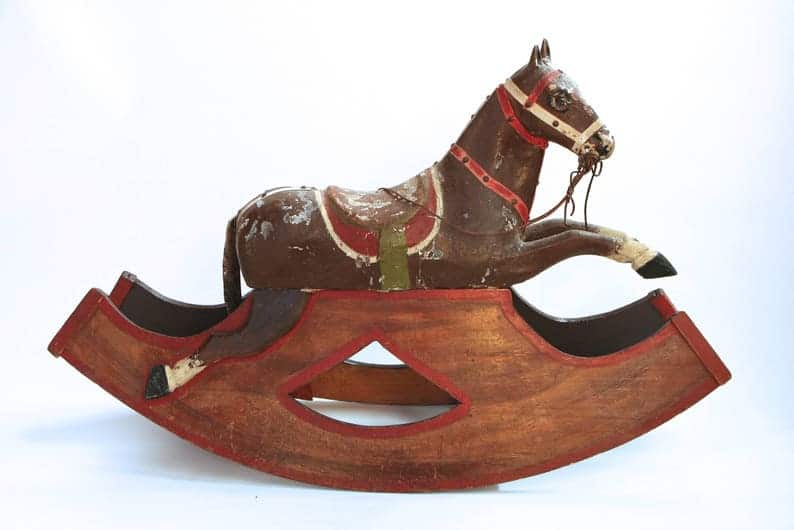
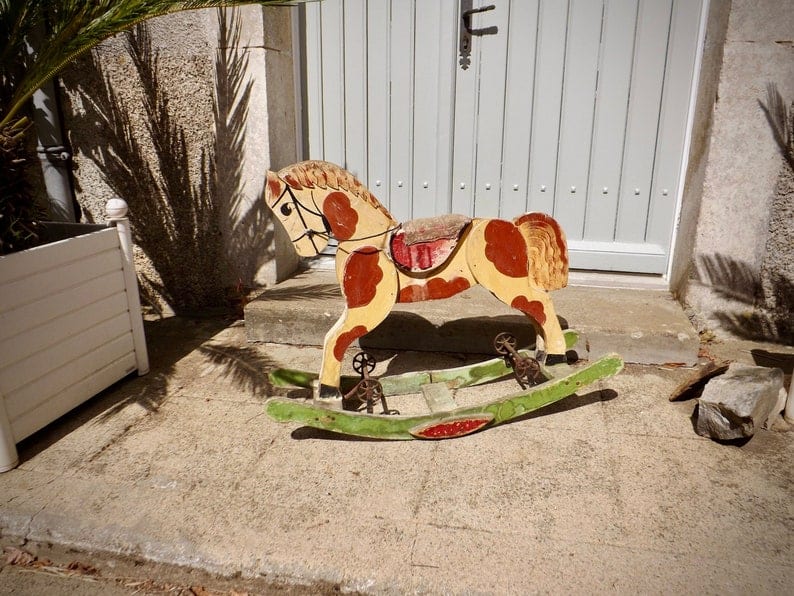
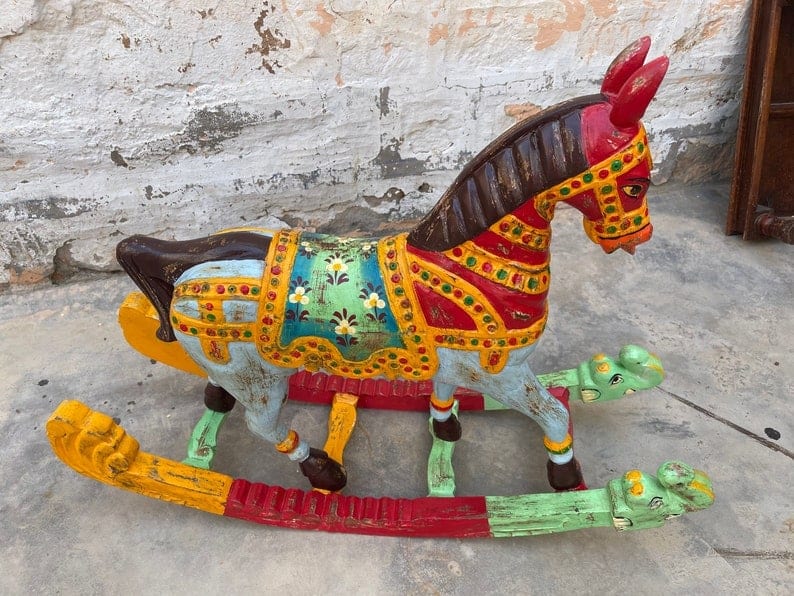
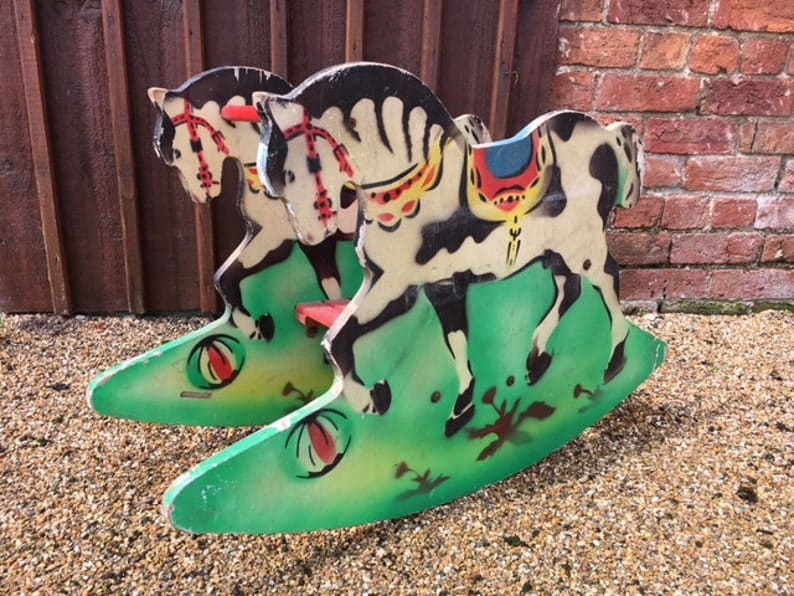
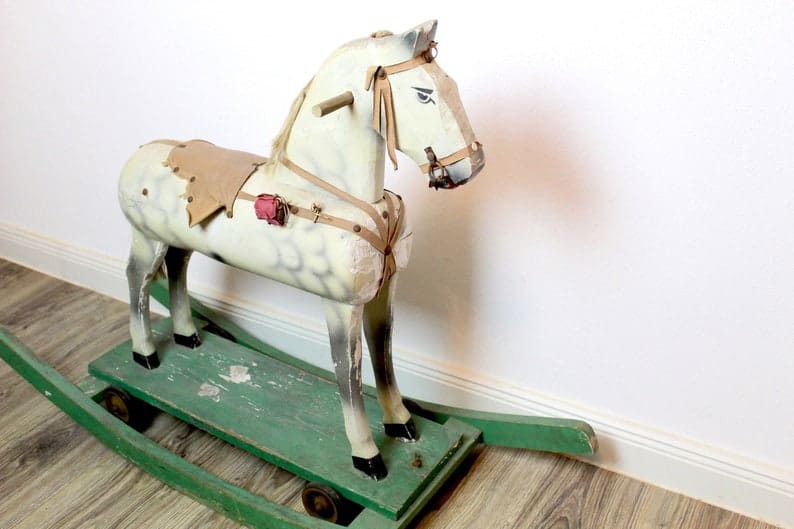
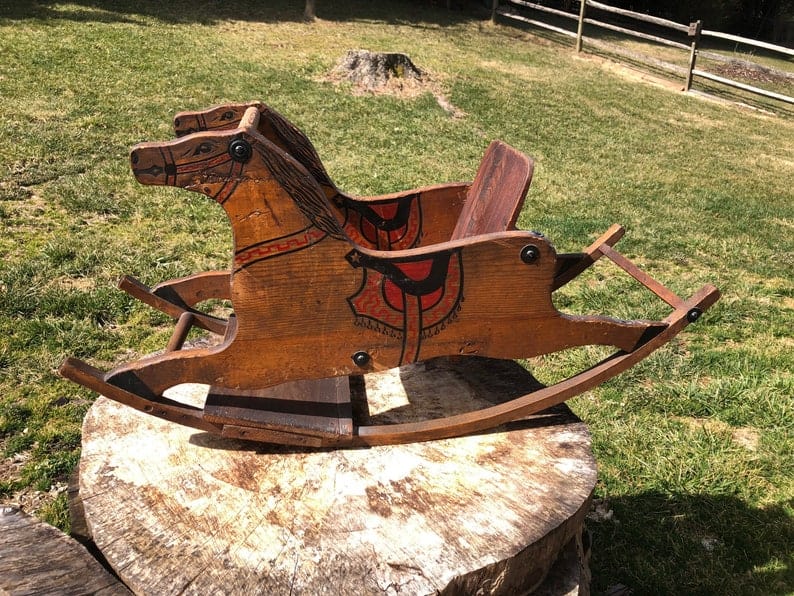
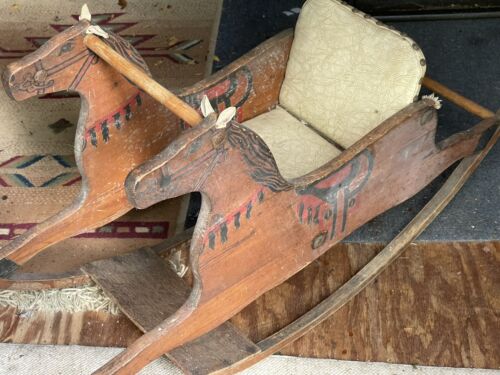
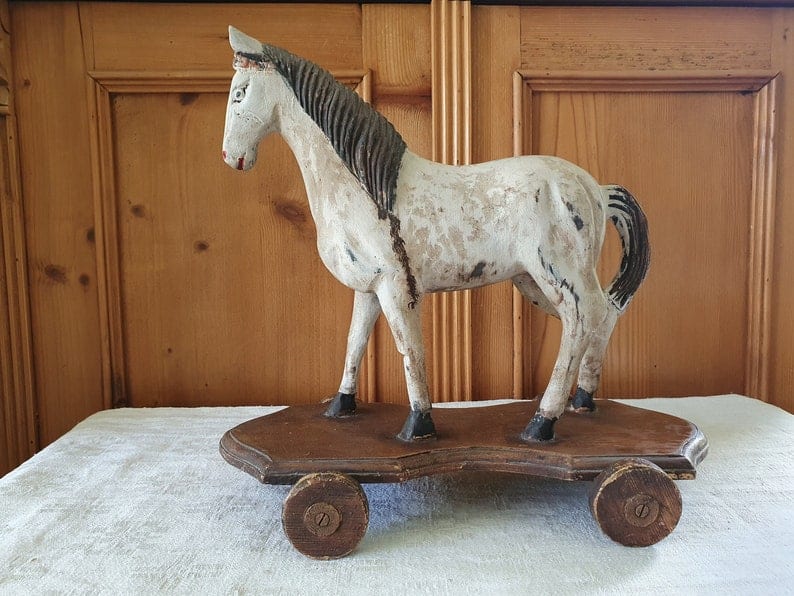
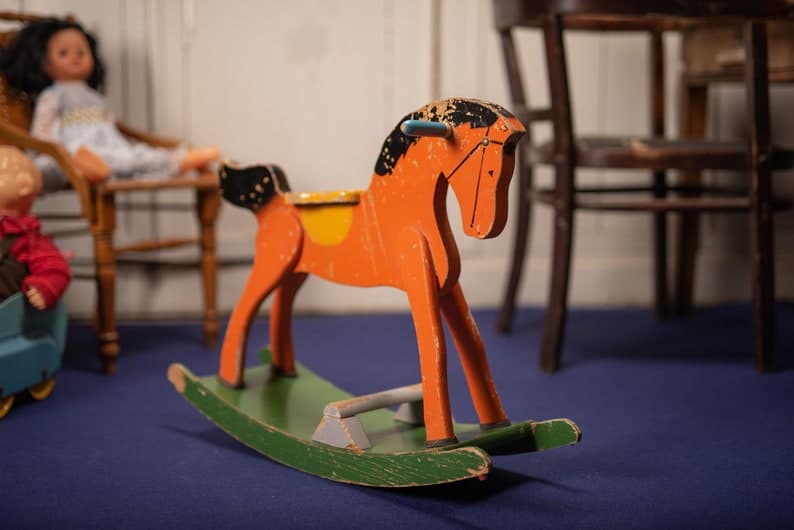
Antique Horse Identification
Numerous manufacturers designed rocking horse toys, but the most famous were those located in England. The quickest way to evaluate their prices is to determine the company that produced these lovely toys.
In most cases, rocking horses came from workshops like Lines, Ayres, Baby Carriage, and Collinson. The only thing you should do is find the markings showing the maker and the decade of production. The list of the best and most common makers includes:
1. Collison Brothers’ rocking horses
This company produced rocking horse toys from 1836 to 1990 in Liverpool. You can recognize their work by a few typical characteristics:
Paintwork – They enjoyed using black and dark shades, plus dappling and bold paint for details. Their toys had recognizable bright red mouths, garish eyes, and nostrils.
Hair – Most of their toy horses came with curly manes and tails.
Eyes – You can notice that their horses feature upholstery pins for eyes.
Tack – This company preferred using the saddle made from leatherette and red corduroy for the saddle middle.
Stand – You can see typical rectangular linear pillars with a diamond cut on their top.
Most antique rocking horses this company manufactured are worth $1,300 to $1,700 on the current market.
2. G & J Lines Brothers’ rocking horses
This London company operated from 1850 to 1931 and created beautiful rocking horses children enjoyed. You can recognize their work for a few typical features, such as:
Paintwork – The company used subtle painting for both horses’ faces and bodies.
Hair – They enjoyed details and created toys’ manes and tails of natural horse hair.
Eyes – Their rocking horses featured eyes made of glass. The company sometimes added lovely details on the horses’ heads.
Tack – Classically shaped removable saddles with angular pointed corners were padded with leather. You can see colorful blankets added below it.
Stand – You can quickly recognize their elegantly turned pillars and hinges with three screw holes. Sometimes, you can notice company initials engraved under brackets or a thistle logo on the martingale front.
These horse toys are highly appreciated nowadays, and the most well-preserved pieces are worth $1,500 to $3,000.
3. F.H Ayres’s rocking horses
This London company was one of the first in the rocking horse business. It was established in 1864 but stopped working in 1914 as soon as WWI began.
Paintwork – Most people firstly notice subtle dappling on their horses’ bodies. However, you should pay attention to exquisitely painted heads, which no other manufacturer could achieve.
Body shape – Rocking horses this company produced were delicately shaped and carved. Their elegant heads were typically turned to one side.
Hair – They used long brown, dapple, or light grey horse hair in most cases.
Eyes – These company’s rocking horses always came with highlighted and beautifully painted glass eyes.
Tack – Each toy had a padded saddle and bridle made of natural leather. Square numnah (horse’s blanket) was uniquely cut with roundish corners. The company used cotton to create this equipment, typically edged with a characteristic white braid.
Stand – The pine stand came with classic turned pillars and hinges with four bolt holes. The curiosity was that the company often mounted their horse toys on bow rockers.
Nowadays, these horses are relatively rare, and you need to set aside $3,000 to $6,000 to buy one.
4. Norton & Barker’s rocking horses
This manufacturer from Birmingham created beautiful rocking horses for children from 1890 to 1947. Their toys were unique, and you could effortlessly distinguish them from others.
Paintwork – Almost all their toys came with elegant basic dappling.
Body shape – These lovely rocking horses had a typically vertical narrow head attached to a stocky body and legs placed straight.
Eyes – This manufacturer made rocking horses with painted eyes outlined with a red line. Therefore, they could look a bit weird since they came without eyelashes.
Tack – Toys typically featured padded leather saddles and almost always came without saddle block.
Stand – Pillars were thin and without a specific shape. Toys’ horizontal rails always came with elegantly rounded ends.
You will rarely find these toys with intact appearance, so most come on the market restored. An average price is $1,450 to $1,800 per piece in decent condition.
5. Baby Carriages LTD’s rocking horses
This company from Liverpool manufactured beautiful rocking horses from 1906 to 1963. Many people often mistakenly confused their toys with those Collison Brothers produced. You can identify one of their pieces by:
Paintwork – Their toys typically contain dappling and bold black shades. However, their work was slightly more delicate than the competing company in Liverpool.
Hair – All their rocking horses featured lovely curly manes and tails.
Eyes – The company always used glass for creating horses’ eyes.
Tack – Horse saddles made from fabric or rarely from leatherette came without saddle block. They typically used cotton for creating numnah, the horse blanket.
Stand – Their linear posts were rectangular with rounded ends and three holes on brackets placed on the stand top.
Horses produced by this company typically cost $500 to $2,000 on the current antique market.
6. Leeway’s rocking horses
The company was founded in London in 1890 and designed lovely rocking horses until 1947. You can quickly recognize their style:
Paintwork – Their rocking horses featured basic dappling.
Body – The first thing to notice is characteristic straight and a bit shapeless legs. These horse toys came with vertical heads on stocky bodies.
Tack – They preferred saddle padded with leather and without block.
Stand – I don’t know why, but their pillars looked unshapely and too thin. The stand came with round-ended horizontal rails.
You can find antique Leeway’s rocking horses for $300 to $900, but some pieces can be more inexpensive. As always, the price will depend on the toy’s condition.
7. Brassington & Cooke’s rocking horses
Since this company operated only in 1920, their rocking horses are considered rare. Their toys are pretty unique, and it is difficult to confuse them with the other models’ appearances.
Body shape – Their horse toys had forward-facing heads, atypically profiled legs, and stocky bodies.
Hair – The company used exclusively natural horse hair to make their toys’ manes and tails.
Tack – They created two saddle models, those made of leather or padded ones.
Stand – The company preferred classic pillars with a bracket pair at each end. Horizontal rails typically came with stylish rounded ends.
Depending on their condition, these rocking horses can be worth anywhere between $550 and $2,000.
Summary
Antique rocking horses were beloved children’s toys in the past, but they are valuable collectibles nowadays. They can be worth only a few dozens of dollars, but well-preserved pieces produced by reputable manufacturers can be costly. Believe it or not, some beautiful toys can reach $2,000 to $7,000 at auctions.
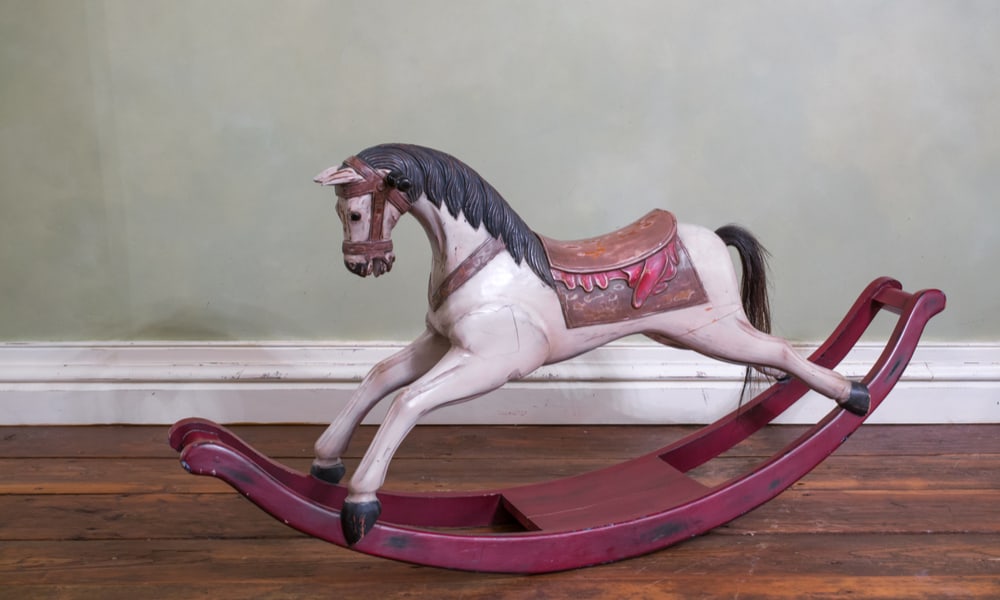
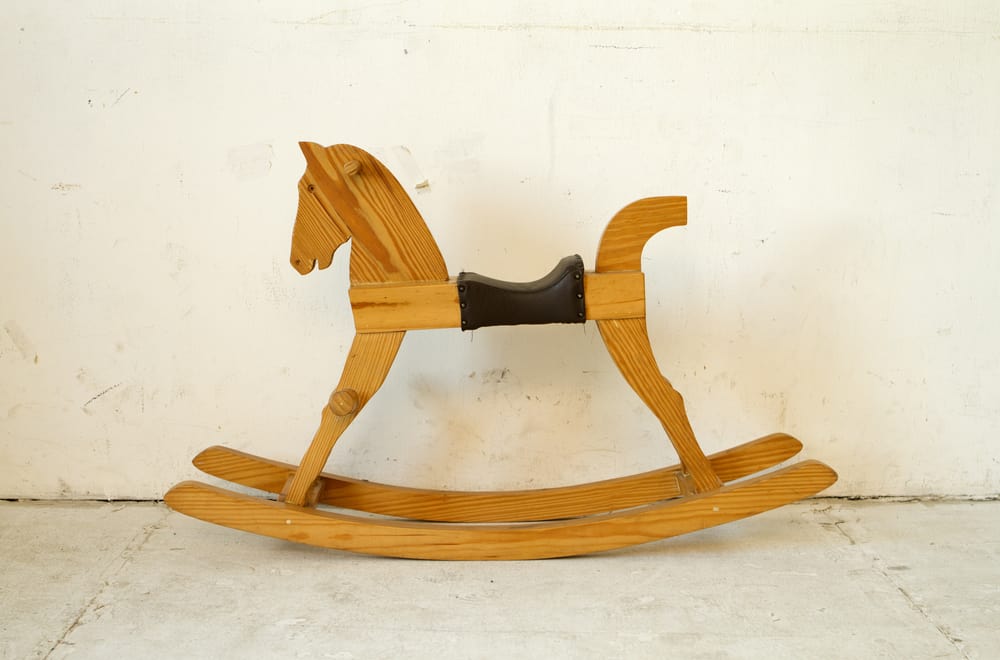
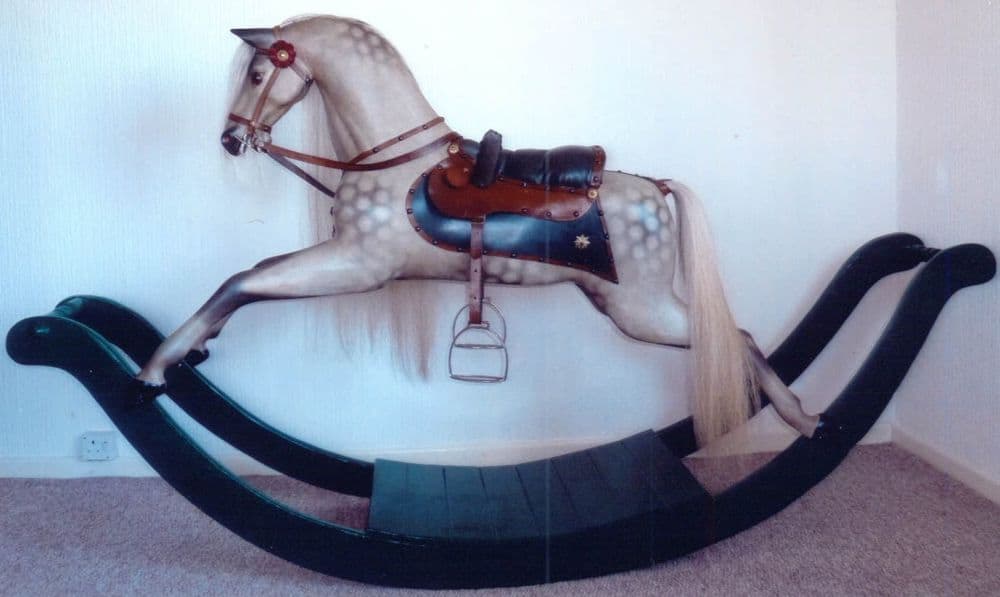
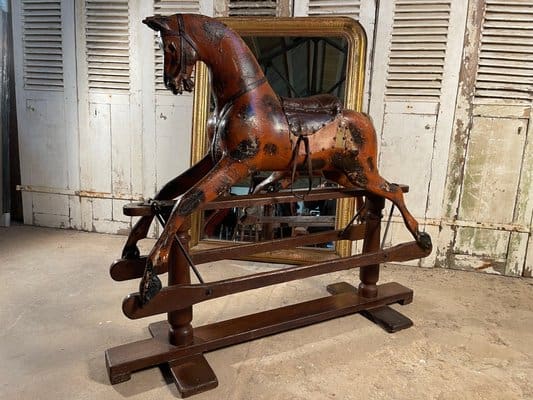
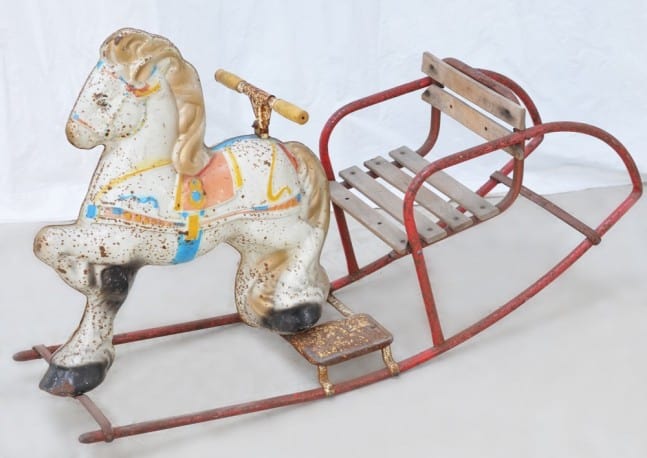
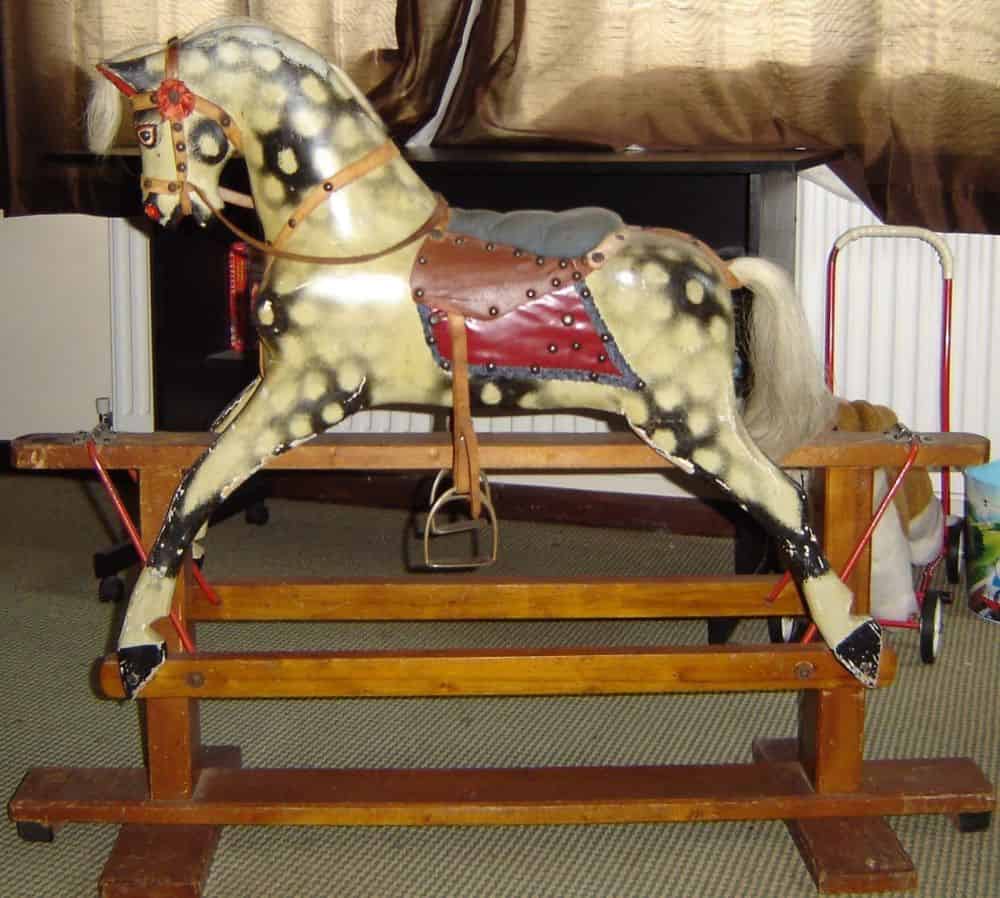
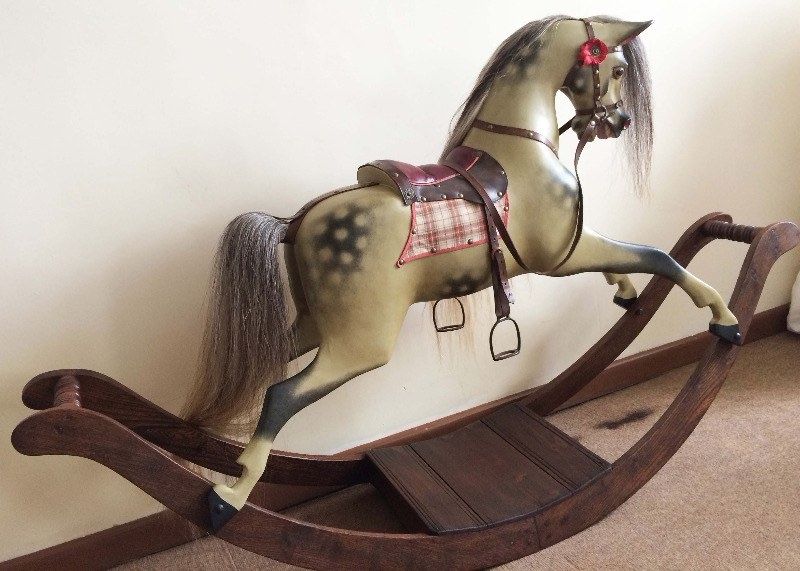
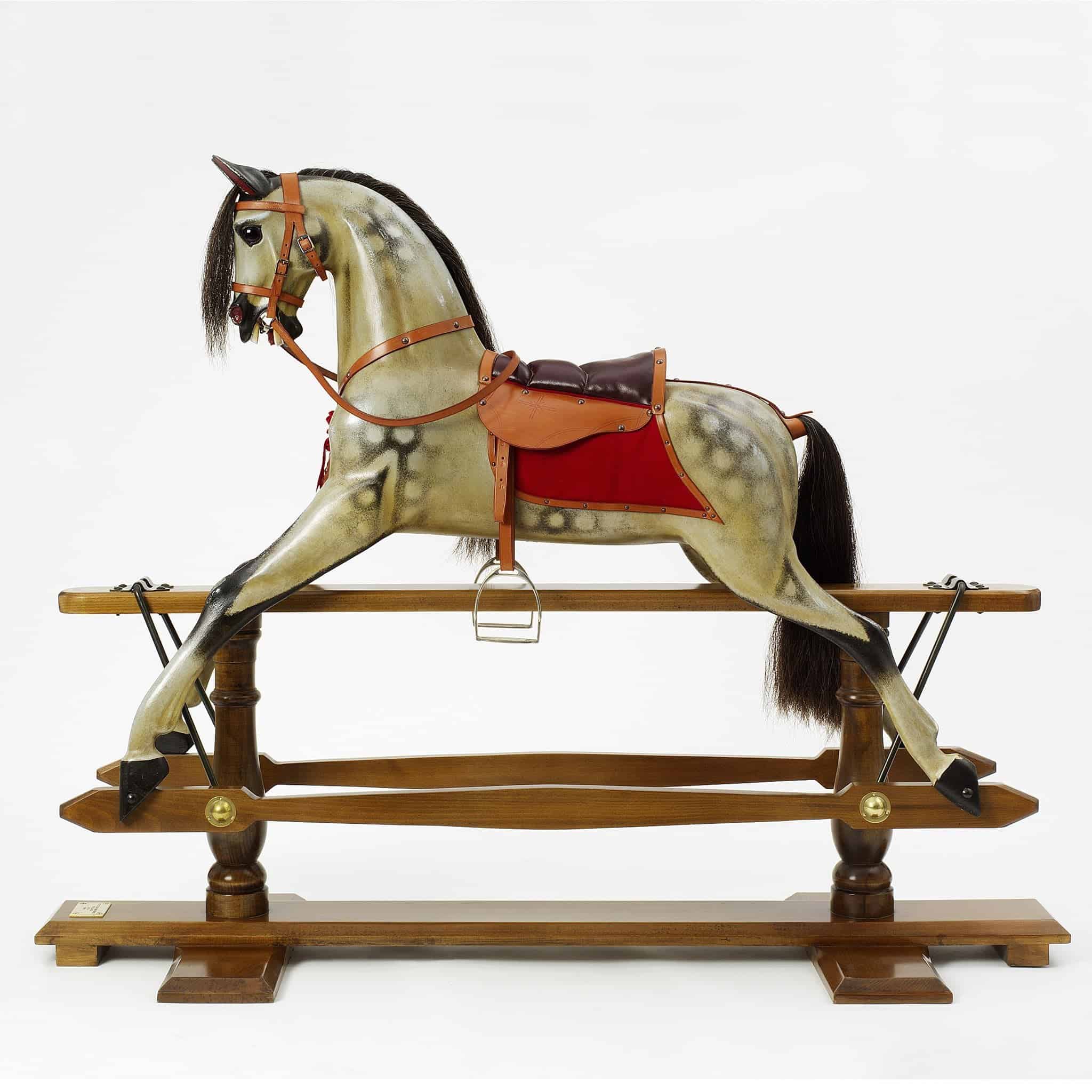
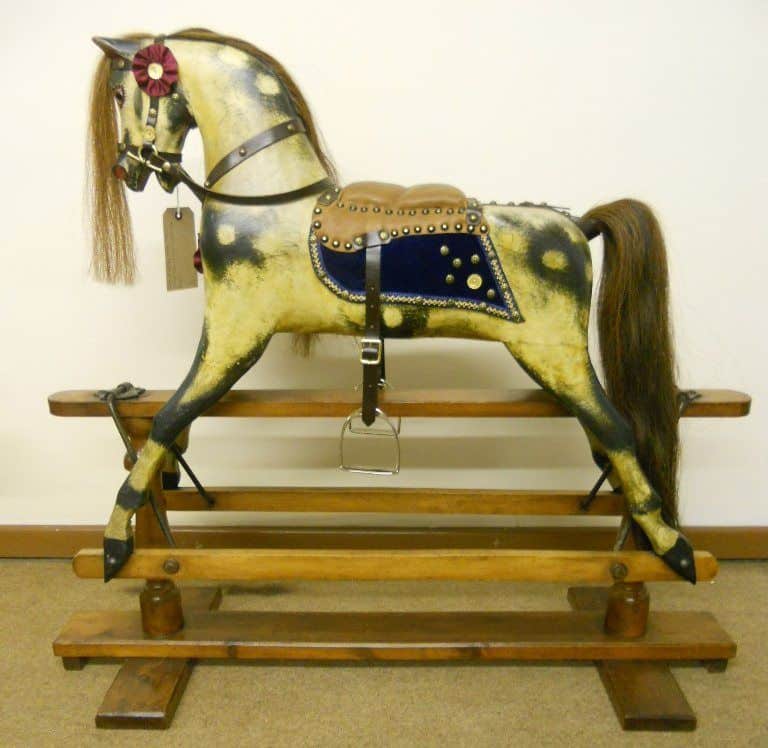
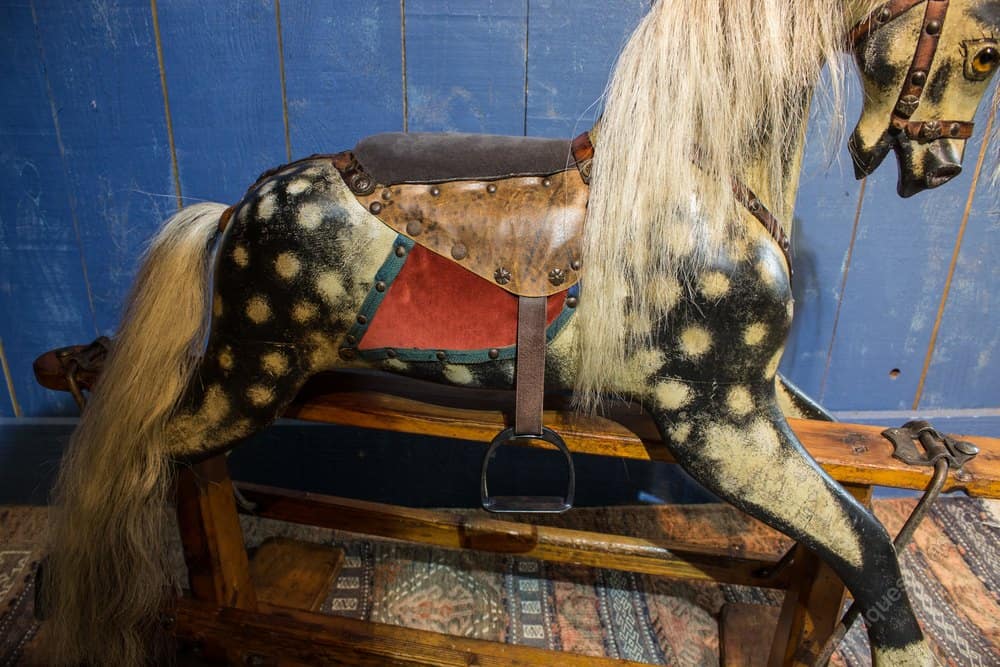
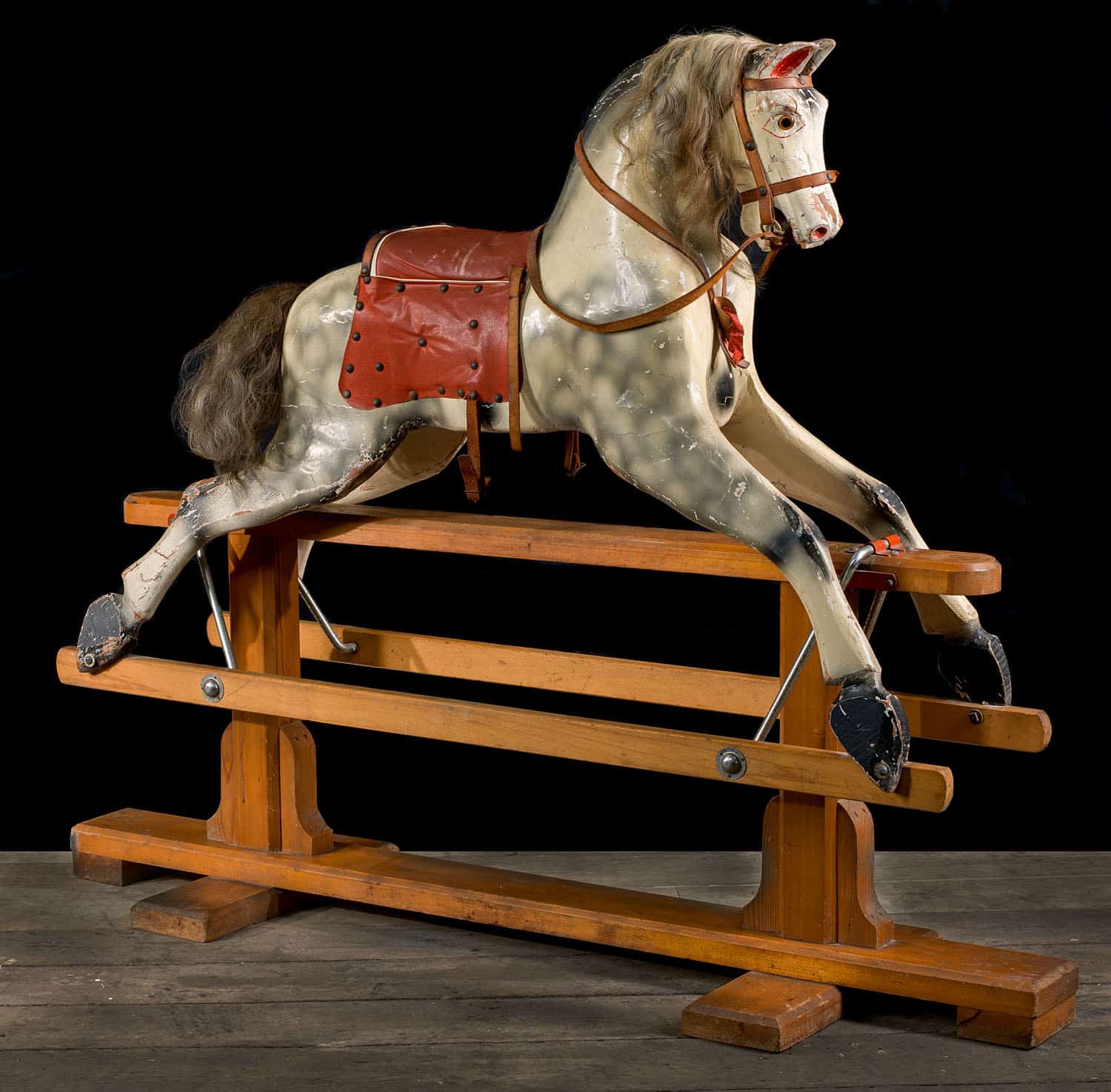
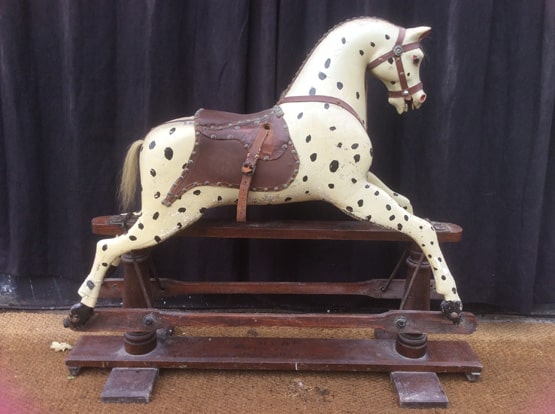
Hi Can you pin point my rocking horse if I email you a picture? Thank you
Thank you for a very informative article on rocking horses. However, I am still unable to identify the one we have even after a lengthy search on the internet. This makes me think it is uncommon or rare. It may be Victorian style. It is on a Marqua type trestle base. It is wood, seat is hand painted. It is small, toddler sized. 24.5″ H x 26″ L (horse is 23″) x 14″ W. I can send photos. Thank you
I have a rare one of a kind Rocking horse that I can not find anywhere on the internet. Do you do valuation on such. Happy to send photos.